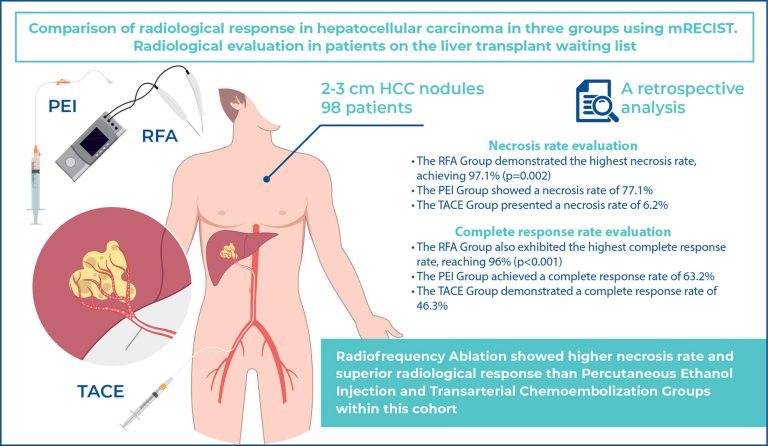einstein (São Paulo). 10/Nov/2025;23:eAO1315.
Comparing radiological response to radiofrequency ablation, percutaneous ethanol injection, and transarterial chemoembolization in patients with hepatocellular carcinoma on the waiting list for liver transplant
DOI: 10.31744/einstein_journal/2025AO1315
Highlights
■ Minimally invasive neoadjuvants are usually recommended for patients on the transplant waiting list.
■ Radiofrequency ablation showed a higher necrosis rate and superior radiological response than did percutaneous ethanol injection and transarterial chemoembolization in this study cohort.
ABSTRACT
Objective:
We aimed to compare the radiological response in small hepatocellular carcinomas treated with radiofrequency ablation, percutaneous ethanol injection, and transarterial chemoembolization using the modified Response Evaluation Criteria in Solid Tumor radiological evaluation in patients on the waiting list for liver transplant.
Methods:
A retrospective analysis was conducted on 98 patients with uninodular tumors of 2–3cm, who were on the waiting list for liver transplantation and underwent radiofrequency ablation, percutaneous ethanol injection, or transarterial chemoembolization as bridging therapies. The patients underwent clinical and radiological follow-up and were assessed for necrosis and radiological response rates using control magnetic resonance imaging after 30–60 days.
Results:
Among the patients, 19, 25, and 54 were in the percutaneous ethanol injection, radiofrequency ablation, and transarterial chemoembolization groups, respectively. Most patients were male, had hepatitis C-induced liver disease, and exhibited a Child-Pugh A status. Imaging control evaluation showed that the radiofrequency ablation group had the highest necrosis rate (97.12%), followed by the percutaneous ethanol injection (77.05%) and transarterial chemoembolization (76.2%) groups (p=0.002). The radiofrequency ablation group showed the highest complete response rate (96%); the percutaneous ethanol injection and transarterial chemoembolization groups had 63.2% and 46.3%, respectively (p<0.001).
Conclusion:
Radiofrequency ablation resulted in a higher necrosis rate and superior radiological response than did percutaneous ethanol injection and transarterial chemoembolization in this study cohort.
[…]
11



